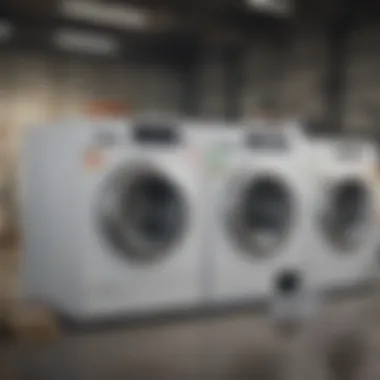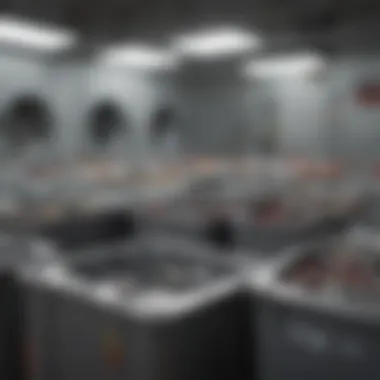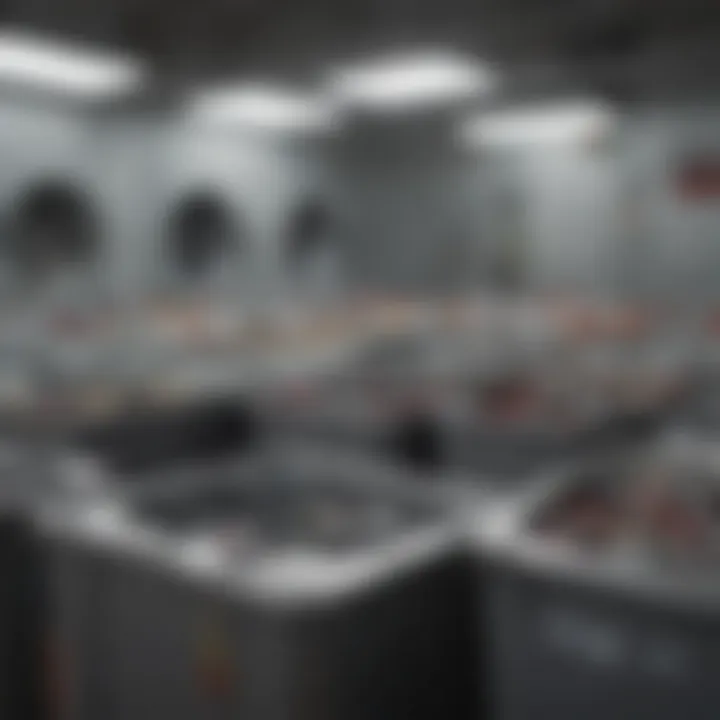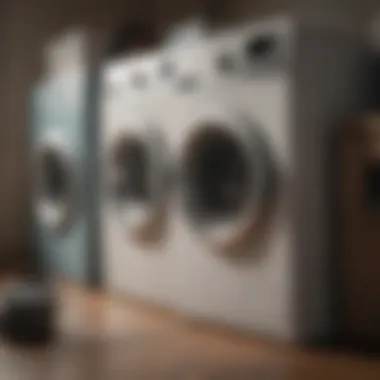Washer and Dryer Recycling Programs: A Detailed Analysis


Overview of the Topic
Washer and dryer recycling programs play a critical role in modern environmental policy and conservation efforts. As we churn through appliances at an alarming rate, the disposal of old washers and dryers poses significant challenges. Millions of these machines make their way to landfills every year, contributing not only to the depletion of natural resources but also to environmental pollution. Understanding the intricacies of appliance recycling is more timely than ever since it intertwines with broader discussions on resource management and sustainable practices.
Preface to the Environmental Issue
Each washer and dryer contains numerous components that are valuable yet potentially harmful if not disposed of properly. Metals, plastics, and chemical substances found in these appliances can leach into soil and waterways, causing long-term ecological damage. Moreover, the unnecessary extraction and processing of raw materials to produce new appliances increases greenhouse gas emissions. Thus, addressing the problem of appliance disposal through effective recycling programs is paramount.
Background Information on the Significance of the Topic
Not only do recycling programs reduce waste, but they also promote resource conservation. By reclaiming metals, plastics, and other materials from old appliances, we reduce the need to mine new resources. Furthermore, successful recycling initiatives can lead to job creation within local communities. This multifaceted issue demands that we look closely at existing recycling programs and their potential to contribute significantly to environmental sustainability.
Current Status and Challenges
Examination of the Current State
Currently, washer and dryer recycling varies widely by region, with some areas having robust programs and others lacking basic disposal facilities. Many consumers are uninformed about the recycling options available to them, leading to widespread appliance disposal in landfills. According to EPA data, only a fraction of old washers and dryers are recycled, which means a substantial amount ends up polluting landfills rather than being repurposed through proper channels.
Identification of Challenges and Threats
There are several challenges in enhancing recycling efforts for washers and dryers:
- Lack of Awareness: Many consumers remain unaware of recycling options.
- Inconsistency in Regulations: Different states have varying rules about appliance disposal and recycling.
- Logistical Issues: Transporting large appliances for recycling can be a challenge for individuals and communities alike.
- Resource Recovery Limitations: Inadequate facilities and technology may hinder the efficient reclamation of materials.
Sustainable Solutions
Exploration of Sustainable Practices
To address the identified issues, stakeholders must explore sustainable practices that can be implemented. This includes promoting increased consumer education about recycling options available in their area. Community outreach programs can play a pivotal role here in connecting users with local recycling resources.
Showcase of Successful Case Studies
Some regions are leading the charge in appliance recycling. For example, the City of San Francisco has adopted extended producer responsibility (EPR) policies. These policies require manufacturers to take back appliances at the end of their life cycle, thus reducing overall waste. Additionally, Best Buy has launched a nationwide recycling program for large appliances, offering convenient drop-off options.
Impact and Importance
Analysis of the Impact
The impact of effective washer and dryer recycling extends beyond immediate waste reduction. Efficient recycling can positively affect ecosystems, helping to maintain biodiversity and protect natural habitats. The communities involved see improvements as well, gaining access to cleaner environments and potential economic benefits through local job creation.
Emphasis on Conservation Efforts
The importance of these recycling programs cannot be overstated. They represent a crucial part of a broader narrative on conservation. As we face increasing threats from climate change and resource depletion, encouraging responsible disposal and recycling practices will become ever more essential. Consumers, businesses, and policymakers all have a role to play in promoting a sustainable future.
"Recycling is not just a trend; it’s a necessity for maintaining our planet’s health and resources for generations to come."
By evaluating the current landscape of washer and dryer recycling, exploring sustainable solutions, and understanding the overarching impact of these initiatives on our environment, we can work together to foster practices that protect our planet for the future. Moreover, every action counts—educating oneself and others makes a world of difference.
Preamble to Washer and Dryer Recycling
Washer and dryer recycling is becoming a crucial topic in today’s world, marked by a rising awareness of environmental sustainability. With many households routinely replacing these appliances, the accumulation of discarded washers and dryers in landfills raises questions about how to dispose of them responsibly. Recycling not only mitigates landfill congestion but also allows for the recovery of valuable materials, reducing the need for new resources. This section sets the stage for understanding the importance of such recycling programs.
Understanding the Need for Appliance Recycling
As appliances like washers and dryers reach the end of their life, they’re often sent to waste dumps without a second thought. This lack of conscientious disposal can lead to several pressing issues.
- Resource Inefficiency: Many components in old appliances, such as metals, plastics, and glass, can be recovered and reused. By opting for recycling instead of trashing them, we’re effectively reducing the extraction of raw materials from our planet.
- Environmental Conservation: Every piece of electronic waste that is recycled significantly cuts down pollution and energy use. For example, recycling aluminum can save 90% of the energy required to produce new aluminum. This means less energy consumption equals a lesser carbon footprint.
Understanding the necessity for recycling is essential for anyone transitioning out of the old and into the new appliance world. It's not just a responsible choice; it's a necessary step toward a sustainable future, one washer and dryer at a time.
The Environmental Impact of Improper Disposal
Throwing a washer or dryer in the trash isn’t merely a wasteful act; it has real, tangible consequences for our planet.
- Toxic Chemicals Leaching: Many appliances contain harmful substances like mercury, lead, and other chemicals, which can seep into soil and waterways when they’re improperly disposed of. This contamination poses a risk to wildlife and can end up affecting human health as well.
- Greenhouse Gas Emissions: When appliances are dumped in landfills, they decompose and emit methane, a greenhouse gas far more potent than carbon dioxide. Thus, a single washer or dryer can contribute to significant environmental harm when considering the collective volume of waste.
- Waste Volume: According to the Environmental Protection Agency, a substantial portion of municipal solid waste comes from appliances. Efficient recycling channels can drastically reduce this waste, contributing positively to municipal efforts to meet waste diversion goals.
"Every year, millions of tons of electronic waste pile up, yet proper disposal methods remain underutilized. We have the tools at our disposal—we just need to use them wisely."


In summary, recognizing the environmental implications of improperly disposing of old washers and dryers underscores the critical role of recycling programs. By engaging in recycling, individuals can actively contribute to a healthier planet, fostering a positive environment for generations to come.
Mechanics of Recycling Programs
Understanding how recycling programs operate is crucial in shaping effective strategies for the recycling of washers and dryers. These appliances are often cumbersome, yet their proper disposal can yield significant environmental benefits. The mechanics involved also highlight the interdependence of various stakeholders: municipalities, recyclers, manufacturers, and consumers. Each plays a role in ensuring that these programs not only operate efficiently but also achieve their intended goals of sustainability and conservation.
How Recycling Programs Operate
Recycling programs typically follow a structured workflow that begins with the collection of old appliances. Local governments or private companies often arrange designated drop-off days or collection events. Appliances like washers and dryers are often large and heavy, adding complexity to the logistics of this process.
Once collected, items are transported to a recycling facility. At this stage, workers sort the appliances to separate metal, plastic, and other materials. Effective sorting can significantly streamline the recycling process, optimizing the recovery of valuable materials.
Another critical component is educating consumers about where to dispose of their old appliances. Many still rely on tossing items in landfills without thinking of the environmental implications. Promoting recycling options—be it through social media, community outreach programs, or local advertisements—enhances participation rates.
Material Recovery Processes
After sorting, the next step involves breaking down the appliances into their constituent parts. Specialized machinery is employed to shred metal and separate materials. For instance, metal components may be melted down for reuse, while plastics might be processed for the creation of new products. Each material has a distinct recovery process, and understanding these processes is vital for maximizing recycling's potential benefits.
Some facilities take it a step further by investing in methods that extract valuable electronics from appliances. This includes circuit boards and small motors that, when recycled, can recover precious metals like gold and silver. Without these advanced processes, precious resources would wind up in landfills, effectively wasting them.
Role of Technology in Recycling
Technology plays a pivotal role in enhancing the efficiency of recycling programs. Advanced equipment, such as automated sorting systems, can improve the accuracy and speed of material recovery. These innovations lessen human error and ensure that materials are sorted correctly, which is essential for compliance with recycling standards.
Furthermore, technology enables tracking and reporting on recycling rates, guiding policy decisions and improvements. Data collected from these systems can foster transparency and inspire confidence among stakeholders by demonstrating the success and environmental impact of recycling programs.
"The mechanics of recycling programs hinge not only on effective logistics but also on the technological advancements that drive material recovery to new heights."
Innovations also extend to the development of specific recycling methods for different materials, harnessing unique characteristics of items like fiberglass or other complex composites often found in modern appliances. By addressing such challenges, recycling programs can adapt to changes in technology and consumer demand.
Policy Framework Supporting Recycling Initiatives
The role of a solid policy framework is vital in fostering effective recycling initiatives for washers and dryers. This structure provides the backbone that guides local governments, organizations, and individuals in sustainable practices. Without such guidelines, the complexities of recycling can overwhelm or even dissuade participation. The importance of carefully crafted policies lies in their capacity to set standards, streamline operations, and ultimately drive community engagement towards responsible recycling.
Regulatory Guidelines at the Local Level
Local regulations vary widely but play a crucial part in setting the stage for appliance recycling. These guidelines often address key aspects such as collection methods, facility requirements, and community participation strategies. Cities and towns may enforce specific rules that dictate how appliances can be disposed of or collected, often requiring recycling instead of the waste of resources.
For instance, some municipalities may organize annual bulk waste collection days, where residents can drop off large appliances. This ensures that rather than ending up in a landfill, these items are directed toward recycling facilities equipped to handle them properly.
Additionally, local governments may provide financial incentives, such as rebates for recycling appliances, encouraging more residents to participate. It's essential for communities to understand these regulations as they set the groundwork for a functioning recycling system.
"An effective local recycling policy is not just about rules; it’s about fostering a culture of sustainability that resonates with residents."
State and National Policies
State and national policies elevate local efforts to a broader scale. They create frameworks that can influence how municipalities develop their own guidelines and operations. For example, many states have enacted Extended Producer Responsibility (EPR) laws that hold manufacturers accountable for the entire lifecycle of their appliances, including end-of-life disposal. This shifts some burden away from local governments and ensures that producers innovate toward more sustainable designs and practices.
National policies may include federal funding for recycling programs or initiatives aimed at promoting technological advancements in recycling processes. These guidelines often address larger concerns such as reducing greenhouse gas emissions or conserving natural resources by emphasizing the recycling of older equipment.
The combination of local and state, as well as national policies, creates a multi-layered approach that encourages participation while providing essential support. Highlighting such regulations can help raise awareness about the importance of recycling, making it an integral part of community and national dialogues.
Challenges in Implementing Recycling Programs
While recycling programs for washers and dryers hold considerable promise in mitigating environmental impact, implementing these initiatives comes with its own set of significant challenges. Understanding and addressing these hurdles is crucial for improving the overall effectiveness of recycling programs. Stakeholders need to be well aware of potential logistical issues and public engagement barriers, as these factors ultimately determine the success or failure of any recycling initiative. With effective strategies, these challenges can be transformed into opportunities for growth and improvement.
Logistical Hurdles
One of the primary obstacles that recycling programs encounter is logistical challenges. The transport of large appliances like washers and dryers is no small feat. Typically, these appliances are heavy and bulky, requiring specialized vehicles for collection. Make no mistake, inefficiencies in logistics lead to increased operational costs, which can deter program sustainability.
Several factors complicate the transportation of such appliances:
- Collection Points: Establishing convenient drop-off points may prove cumbersome. Oftentimes, residents lack access to these facilities, making the recycling process feel out of reach.
- Schedule Coordination: Synchronizing collection schedules with residents' timeframes can spark frustration. An inflexible schedule often results in wasted trips or missed collections.
- Recycling Facility Capacity: Not every community has a recycling facility equipped to handle these appliances. Limited capacity can lead to backlogs, causing delays and discontent.
It’s imperative to strategize effectively to mitigate these logistical challenges. Developing partnerships with local waste management services can streamline collection efforts, while leveraging technology for scheduling updates may enhance service delivery.
Public Awareness and Participation


Another critical aspect pertains to public awareness and engagement. Recycling programs thrive not merely on state infractions but also on active public participation. From the ground up, effective communication is needed to ensure residents know the options at their disposal and the necessity of recycling their old appliances.
- Knowledge Gaps: Many individuals remain unaware of how and where to recycle used appliances. This lack of information breeds apathy, leading people to dispose of these items irresponsibly.
- Myths and Misconceptions: Common misconceptions, such as the belief that recycling is too complicated or that it costs money, further hinder participation. These myths can deter potential recyclers who may otherwise take part in the initiative.
- Incentives: Public programs often lack enticing incentives to motivate residents. Reward systems or community challenges could serve to foster greater involvement.
Effective outreach campaigns that emphasize the environmental benefits and offer clear guidance can transform community attitudes and inspire greater engagement in recycling practices.
"Thorough communication and participatory initiatives can turn the tide on public apathey, turning a lukewarm interest into a passionate commitment to recycling."
In summary, the hurdles surrounding logistics and public engagement in recycling programs must be tackled head-on. By implementing practical strategies and employing effective communication, stakeholders can progress toward more successful recycling initiatives, contributing to a greener future.
Benefits of Recycling Appliances
Recycling appliances like washers and dryers has become a significant focus in modern sustainability initiatives. Not only does it help mitigate environmental issues but it also fosters a more sustainable approach to resource usage. The benefits are multi-fold, touching on resource conservation, enhancing energy efficiency, and reducing landfill waste. As we explore these aspects, it's crucial to recognize how effective recycling not only caters to immediate needs but also paves the way for long-term environmental health.
Resource Conservation
When we talk about resource conservation, one must consider the materials that go into growing, manufacturing, and maintaining appliances. For instance, a dryer can contain metal, plastic, and rubber, each requiring energy and raw materials to produce. Recycling reduces the dependence on these virgin resources. Instead of mining for new metals or synthesizing new plastics, the existing materials can be processed and reused.
- Metals from old appliances can be melted and reshaped into new products, sparing the environment from additional surface mining.
- Plastics can be reground and repurposed, which diminishes plastic waste in our landfills and oceans.
By recycling, we are essentially engaging in a practice that keeps materials in use longer, making the most of what the Earth provides. This approach not only protects the ecosystem but significantly curtails the carbon footprint associated with material extraction.
Energy Efficiency Gains
It's astonishing how appliance recycling contributes to energy savings. The energy required to extract and process new materials often far exceeds what is needed to recycle existing ones. For example, recycling aluminum saves about 90% of the energy compared to producing it from raw materials.
When appliances are recycled properly, we funnel energy savings back into the system. This means that:
- Less energy consumption translates to fewer fossil fuels burned, supporting cleaner air and less greenhouse gas emission.
- Efficient recycling processes also tend to yield more energy-efficient newer models, creating a cycle of improved efficiency.
In this way, energy efficiency not only addresses immediate concerns but also ensures that future generations inherit a cleaner and more sustainable usage line.
Reduction of Waste going to Landfills
One of the most pressing challenges of our time is the mounting waste entering landfills. Appliances like washers and dryers are bulky, heavy, and take up considerable space in these dumps. When these old machines are irresponsibly discarded, they contribute to overflowing landfills, which leads to soil contamination and greenhouse gas emissions as they decompose.
A proper recycling framework can significantly cut down on this waste. Here’s how:
- Contributing to a circular economy: Each recycled appliance can be turned into components for new products, thus dramatically reducing the waste that ends up in landfills.
- Encouraging responsible disposal practices: As communities become more aware of appliance recycling options, they are more likely to engage with programs designed to recycle, rather than simply throw away.
To sum up, recycling washers and dryers is not just about getting rid of old appliances. It's about embracing a holistic approach towards conserving resources, saving energy, and reducing waste. Such practices reflect a commitment to the environment that benefits not just individuals, but the collective future of our planet.
"Recycling isn’t just an option; it’s a responsibility of our generation to ensure a better world for the next."
By prioritizing these benefits, we take meaningful strides toward a healthier and more sustainable society.
Visit Wikipedia or Britannica for deeper insights into the recycling processes and their implications.
Community Engagement in Quality Recycling
Engaging local communities in recycling initiatives is pivotal for the success of washer and dryer recycling programs. Not only does community involvement enhance environmental awareness, but it also fosters a culture of sustainability. When residents feel invested in recycling efforts, the likelihood of their participation increases, resulting in a decrease in improperly disposed appliances and a significant boost in resource recovery. Awareness is key; the more informed the public is about the recycling process and its benefits, the more likely they will be to support and engage in these initiatives.
Educational Initiatives
Educational initiatives play a fundamental role in enhancing community engagement. Programs designed to inform the public about the processes and benefits of appliance recycling can instigate powerful changes in behavior. Schools, community centers, and local governments can take the lead in hosting workshops and informational sessions. These platforms allow residents to educate themselves about the environmental impact of old appliances and the recycling pathways available.
For instance, workshops could include:
- Hands-on demonstrations of appliance disassembly to illustrate how materials are recovered.
- Informative talks by experts discussing the broader environmental effects of textiles and appliance waste.
- Resource distribution such as pamphlets or digital content that highlight nearby recycling facilities.
Moreover, creating digital content through social media can also capture the attention of younger audiences, further spreading awareness.
Partnerships with Local Organizations
Forging partnerships with local organizations is essential to amplify recycling efforts. Community groups, nonprofits, and even businesses can collaborate to enhance resources, share knowledge, and promote recycling events. Each participating entity brings unique insights and capabilities to the table.
- Nonprofits dedicated to environmental preservation often have the expertise to guide recycling programs, providing valuable educational materials and outreach strategies.
- Local businesses can host collection events where residents can drop off old appliances, often incentivizing them with discounts or offers to promote participation.
- Schools and educational institutions can serve as vital partners, engaging students in practical recycling initiatives. For example, a student-led project could involve organizing community drives to collect old appliances, teaching them about hands-on recycling efforts and responsibility.


Such collaborations can create a synergistic effect, broadening outreach and maximizing participation while building a stronger community around the shared goal of environmental sustainability.
"Community engagement isn’t just a nice-to-have; it's the backbone of effective recycling programs. When communities band together, they can turn the tide on waste management issues."
By fostering community engagement through educational initiatives and partnerships, washer and dryer recycling programs can grow more robust, creating a more sustainable environment for all.
Case Studies of Successful Programs
Examining case studies of successful recycling programs reveals critical insights into best practices and innovative approaches. These examples not only underscore the feasibility of these systems but also highlight their benefits. Ultimately, understanding how various communities implement their recycling initiatives can guide stakeholders in enhancing their own programs.
Innovative Practices in Urban Settings
In urban areas, the population density and variety of appliances create unique challenges for recycling initiatives. Here, innovative practices have emerged to address these obstacles. For instance, in San Francisco, the city implemented a city-wide collection program that operates through designated drop-off locations. This makes it easy for residents to recycle old washers and dryers at their convenience. The positive effect? A significant increase in participation rates.
Another example is New York City, where the Department of Sanitation partnered with local tech firms to develop an application that allows residents to schedule pick-ups for large appliances, including washers and dryers. This tech-savvy approach not only reduces logistical burdens but also raises awareness of recycling options.
Moreover, during special events like “Green Up Day,” many urban areas encourage residents to bring appliances for recycling. The communal feel of these events fosters a sense of responsibility and pride in keeping the community green. These cities showcase how urban recycling programs can be both functional and accessible, making strides in reducing waste.
Rural Initiatives and Their Outcomes
In contrast, rural areas face distinct challenges, often tied to geographic isolation and limited resources. However, some communities have devised noteworthy strategies that reveal the power of collaboration. For example, in small towns across Vermont, community centers have become recycling hubs, where collections for bulky items like dryers are organized periodically. Collaborations with regional waste management programs ensure that these collections are efficient and cost-effective. The results have been impressive: communities that once relied on landfills have noticeably reduced their waste through these strategic partnerships.
Additionally, Illinois has initiated outreach programs targeting farmers and rural residents, educating them on the importance of recycling old appliances. Mobile collection units travel to these areas, providing a service that otherwise would be inaccessible. Participants in these programs report increased understanding of environmental issues and a stronger commitment to sustainability.
Overall, the success stories from both urban and rural programs demonstrate the potential for innovative solutions tailored to those specific contexts. They highlight how different communities can learn from each other, ensuring that recycling practices become a part of everyday life, regardless of location.
Future Perspectives in Appliance Recycling
The landscape of appliance recycling is on the brink of significant transformation. As we look ahead, it becomes clear that the future holds vast potential for innovative practices aimed at enhancing the recycling of washers and dryers. The significance of this topic is twofold: it not only addresses the pressing concerns of waste management and resource conservation but also steers us toward sustainable habits that can have lasting effects on our environment.
Technological Developments on the Horizon
One cannot overlook how rapidly technology evolves; it has fundamentally changed how we recycle appliances. For instance, the advent of smart recycling machines that can selectively disassemble parts of appliances is a game changer. With mechanisms that can identify various materials and separate them automatically, the efficiency of recycling processes is likely to skyrocket.
Moreover, advancements in artificial intelligence and machine learning could streamline sorting processes even further. A prime example might be the development of AI systems that can evaluate the condition of various parts in real-time to determine their viability for reuse or recycling.
In conjunction, increased automation in recyclin facilities could facilitate better operational efficiency. Imagine a facility where robots handle the heavy lifting, allowing human workers to focus on strategic tasks such as quality control and oversight.
"Tech-driven solutions will redefine how we view washing machines and dryers at the end of their life cycle. Instead of mere waste, they become valuable resources."
The development of sustainable materials is another exciting avenue. As manufacturers start integrating recyclable materials into new products, the closed-loop concept of recycling takes shape. If washers and dryers are designed with recycling in mind, it can significantly mitigate the challenges faced in traditional processing methods.
Potential Legislative Changes
Legislation plays a pivotal role in shaping the future of appliance recycling programs. One notable trend is the tightening of regulations surrounding e-waste and bulky appliances. Many countries are enacting stricter rules aiming to curb the improper disposal of such items and promote responsible recycling.
For example, extended producer responsibility (EPR) regulations are becoming a cornerstone in legislative frameworks. These laws hold manufacturers accountable for the entire lifecycle of their products, pushing them to innovate in designing eco-friendly appliances that can be easily recycled or repurposed. This can lead to improved product designs that either minimize waste or utilize alternative materials.
Furthermore, potential tax incentives for recycling initiatives could motivate both companies and consumers to engage in responsible disposal practices. These considerations present a dual benefit: enhancing public participation in recycling programs while shoring up community resources for environmental education.
If public policies begin to align with technological advancements, we could see a marked increase in both participation and the efficiency of recycling efforts. To maximize the benefits, collaboration among industry stakeholders, government entities, and the public is crucial.
Epilogues and Implications
The exploration of washer and dryer recycling programs shines a light on the crucial role they play in fostering environmental sustainability. As we’ve seen throughout the article, these initiatives are not merely about getting rid of old machines; they present a multifaceted approach to resource management and public welfare.
Summarizing Key Insights
In summary, several key insights emerge from our deep dive into recycling programs:
- Environmental Benefits: By diverting appliances from landfills, recycling significantly reduces the impact on the environment. This practice limits greenhouse gas emissions and conserves valuable energy and materials that would otherwise be wasted.
- Educational Role: The initiatives foster a culture of awareness and proactive participation in community recycling efforts. When people understand the why and the how behind these programs, they are more likely to engage, leading to better overall outcomes.
- Economic Potential: Not only does recycling gadgets like washers and dryers help protect nature, but it can also drive innovation within the recycling industry, creating jobs and boosting local economies.
- Community Initiatives: Engaged communities are better at implementing successful programs. Whenever local organizations, trash services, and residents collaborate, the more effective the recycling becomes.
In essence, recycling old appliances is a bigger picture; it reflects our societal values and priorities around sustainability and resource utilization.
Call to Action for Stakeholders
For stakeholders such as local authorities, manufacturers, and environmental groups, the time to act is now. Here are some suggestions on how to contribute effectively:
- Advocacy: Promote policies that support recycling initiatives. Your voice is powerful and can create the necessary push for legislative support.
- Partnerships: Build bridges between local businesses and community organizations. Collaborative events can raise awareness and improve participation in recycling efforts.
- Education and Outreach: Develop campaigns aimed at educating the public about the benefits of recycling. Materials can include pamphlets, social media posts, and community workshops.
- Innovation: Invest in technology that improves the efficiency of recycling processes. Supporting startups focused on recycling tech can make a substantial difference in the outcomes of these programs.
“The road to a sustainable future is paved with informed choices and community engagement.”
Overall, the implications of implementing effective washer and dryer recycling programs are manifold and significant. They touch upon environmental stewardship, economic viability, and the fostering of community relationships. By taking decisive steps, we can ensure that our actions today lead to a brighter tomorrow for the environment.



